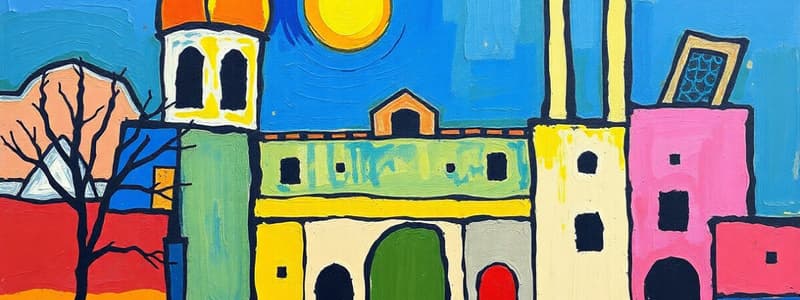Podcast
Questions and Answers
What is a significant characteristic of Byzantine painting?
What is a significant characteristic of Byzantine painting?
- Use of abstract forms and bright colors
- Focus on human emotions and landscapes
- Depiction of Christian subjects (correct)
- Incorporation of realistic bodily proportions
Which architectural feature is most associated with Byzantine advancements?
Which architectural feature is most associated with Byzantine advancements?
- Pointed arches
- Flying buttresses
- Domes (correct)
- Gothic spires
Which of the following describes the painting style of Romanesque art?
Which of the following describes the painting style of Romanesque art?
- Strict frontal poses with elongated features (correct)
- Dynamic poses with movement
- Use of chiaroscuro to enhance depth
- Integration of detailed backgrounds
What distinguishes Romanesque architecture from Gothic architecture?
What distinguishes Romanesque architecture from Gothic architecture?
What common feature is found in Romanesque sculpture?
What common feature is found in Romanesque sculpture?
Which of the following elements is NOT associated with Gothic art?
Which of the following elements is NOT associated with Gothic art?
The Last Judgment by Gislebertus is known for being part of which architectural feature?
The Last Judgment by Gislebertus is known for being part of which architectural feature?
In which century did Gothic art primarily develop?
In which century did Gothic art primarily develop?
Flashcards are hidden until you start studying
Study Notes
Byzantine Art
- Focuses on Christian subjects, especially during the 11th century.
- Styles merged Greek and Oriental influences, resulting in grand imagery in churches.
- "The Empress Theodora" mosaic from the 6th century AD, located in San Vitale, Ravenna, depicts a significant figure in Byzantine culture.
- Theodora described as an Asian queen with fierce expression; characterized by dark features.
- Byzantine advancements in dome construction introduced a new architectural style globally.
- Mastery of mosaic decoration was a hallmark of Byzantine churches.
Romanesque Art
- Flourished in Europe around 1000 AD, serving as a bridge between Roman and Gothic art.
- Romanesque paintings often consist of mosaics on church walls, characterized by a strict frontal pose.
- Human figures depicted with elongated faces, large eyes, and prominent noses against flat colored backgrounds.
- Key sculptural works include reliquaries, altar frontals, crucifixes, and devotional images, often made from luxurious materials.
- "The Last Judgment" by Gislebertus is a notable example found in the west tympanum of Cathédrale Saint-Lazare d’Autun.
Romanesque Architecture
- Marked by solid masonry walls, rounded arches, and vaulted ceilings.
- Significant building boom in Europe led to the construction of castles, churches, and monasteries.
- Grand sculptured portals define Romanesque church doorways, framed by elaborate stone sculptures.
Gothic Art
- Emerged in Northern France in the 12th century, evolving from Romanesque art.
- Characterized by taller structures, intricate details, and more light-filled interiors.
- Notable features include pointed arches, ribbed vaults, and flying buttresses that allowed buildings to soar higher and exhibit larger windows.
Studying That Suits You
Use AI to generate personalized quizzes and flashcards to suit your learning preferences.




